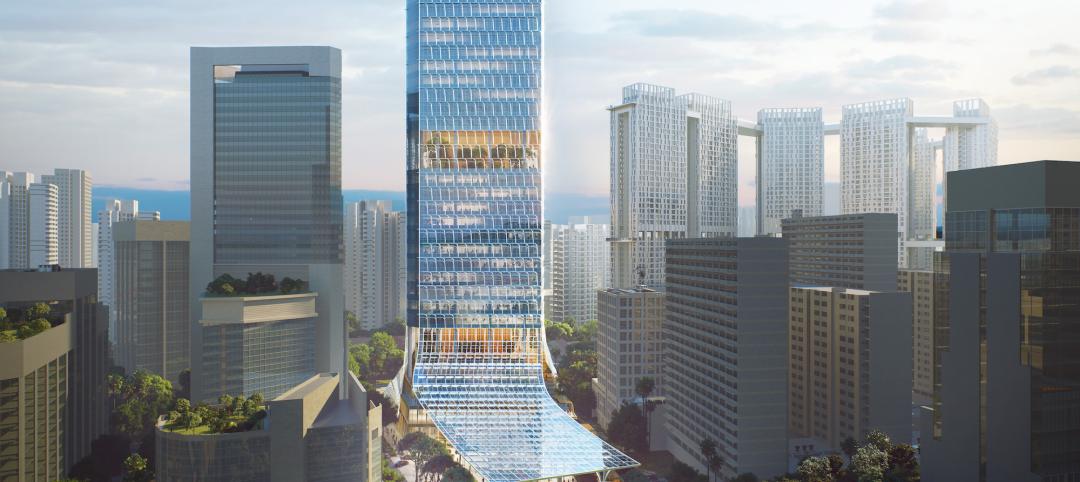The taller the building, the more prestigious it appears. At least, that’s how the thinking goes. Recently, cities around the world are beginning to use tall buildings to show off their wealth and prosperity in the same way professional athletes use garages filled with Ferraris, Aston Martins, and Lamborghinis.
Sure, tall buildings provide a way of maximizing space in crowded cities, but a report from the Council on Tall Buildings and Urban Habitat (CTBUH) points to the fact that many supertalls around the world have hundreds of feet of non-occupiable space. This “vanity height” as it is referred to, exists purely as a design element and to make the building taller.
In fact, if you eliminate vanity height, 44 of the world’s 72 supertalls (the number at the time of the report using July 2013 data) would measure less than 300 meters, losing their supertall status. The tallest of these building’s is Guangzhou’s 390-meter CITIC Plaza. Seeing these tall buildings only to realize so much of it is purely for aesthetics is like buying a large bag of chips only to discover a third of it is filled with air.
In terms of sheer height, the Burj Khalifa is the most egregious vanity height offender. 244 meters at the top of the world’s tallest tower is non-occupiable, that’s a whopping 800 feet. In other terms, if the Burj Khalifa’s vanity height were a building in its own right, it would be Europe’s 11th-tallest building.
In terms of percentage, another Dubai building is the worst offender. 39% of the Burj Al Arab’s height is non-occupiable space. However, at the opposite end of the spectrum, Dubai is also home to The Index, which has a vanity height of only four meters, or 1% of the buildings overall height.
New York has three of the worst offenders with the Bank of America Tower (131 meters, 36%), New York Times Tower (99 meters, 31%), and One World Trade Center (134 meters, 25%). The Empire State Building, however, plays the role of New York’s Index, as it loses just 1% of its height to non-occupiable space.
Measuring building height has been a fairly subjective practice over the years. Spires are counted toward height (which some view as counterproductive and rewarding vanity height) while antennae are not. In 1998, the then Sears Tower lost its title of tallest building in the world to Petronas Towers despite being almost 250 feet taller when its antennae were included and also having a higher occupiable top floor. The Petronas Towers’ spires, which are included in the building’s height, reach 1,483 feet in the air while the Sears Tower without its antennae, which are not included in its overall height, only reaches 1,454 feet. With the antennae the Sears Tower is 1,707 feet.
The now Willis Tower lost out again to vanity height in determining the tallest building in the United States. The Willis Tower’s roof is 442.1 meters high while One World Trade Center’s roof is 417 meters high. Again, however, One World Trade Center’s spire counts towards its height, bringing it up to 1,776 feet and giving it the distinction of being the tallest building in the U.S.
So what does all of this mean? Well, not much, except the list of the tallest buildings in the world would be shuffled around a bit if spires, masts, and antennae were counted toward a building’s overall height or, conversely, if buildings were just measured to their top floors.
But there really isn’t a simple solution: completely occupiable or not, the Burj Khalifa is still the tallest structure ever created (to this point. Jeddah Tower will take the title when it is completed, most likely with quite a bit of non-occupiable space of its own). But if you allow spires, antennae, or other non-occupiable components to count, then some architects and developers could add comically large elements to their structures just to get the accolade of tallest structure in the world.
Regardless, whichever way you measure it, architects are continuing to push the boundaries of what is possible in terms of building height as more tall buildings than ever are popping up in cities around the world.
Related Stories
Office Buildings | Aug 10, 2023
Bjarke Ingels Group and Skanska to deliver 1550 on the Green, one of the most sustainable buildings in Texas
In downtown Houston, Skanska USA’s 1550 on the Green, a 28-story, 375,000-sf office tower, aims to be one of Texas’ most sustainable buildings. The $225 million project has deployed various sustainable building materials, such as less carbon-intensive cement, to target 60% reduced embodied carbon.
MFPRO+ New Projects | Aug 4, 2023
Nashville gets 'first-of-its-kind' residential tower
Global architecture firm Goettsch Partners announces the completion of Alcove, a new 356-unit residential tower in Nashville, Tenn., developed by Giarratana LLC.
MFPRO+ New Projects | Jul 27, 2023
OMA, Beyer Blinder Belle design a pair of sculptural residential towers in Brooklyn
Eagle + West, composed of two sculptural residential towers with complementary shapes, have added 745 rental units to a post-industrial waterfront in Brooklyn, N.Y. Rising from a mixed-use podium on an expansive site, the towers include luxury penthouses on the top floors, numerous market rate rental units, and 30% of units designated for affordable housing.
High-rise Construction | Jul 26, 2023
A 33-story Singapore tower aims to reimagine work with restorative, outdoor spaces
Architecture firm NBBJ has unveiled design details for Keppel South Central, a commercial tower in Singapore. The project, which is slated for completion in late 2024, will transform the original Keppel Towers into a 33-story, energy-efficient building that aims to reimagine work by providing restorative spaces and connections to the outdoors.
High-rise Construction | Jul 25, 2023
World's largest market-rate, Phius Design-certified multifamily high-rise begins leasing
The Phius standard represents a "sweet spot" for aggressive decarbonization and energy reduction, while remaining cost-effective.
Sponsored | Fire and Life Safety | Jul 12, 2023
Fire safety considerations for cantilevered buildings [AIA course]
Bold cantilevered designs are prevalent today, as developers and architects strive to maximize space, views, and natural light in buildings. Cantilevered structures, however, present a host of challenges for building teams, according to José R. Rivera, PE, Associate Principal and Director of Plumbing and Fire Protection with Lilker.
Multifamily Housing | Jun 28, 2023
Sutton Tower, an 80-story multifamily development, completes construction in Manhattan’s Midtown East
In Manhattan’s Midtown East, the construction of Sutton Tower, an 80-story residential building, has been completed. Located in the Sutton Place neighborhood, the tower offers 120 for-sale residences, with the first move-ins scheduled for this summer. The project was designed by Thomas Juul-Hansen and developed by Gamma Real Estate and JVP Management. Lendlease, the general contractor, started construction in 2018.
Apartments | Jun 27, 2023
Dallas high-rise multifamily tower is first in state to receive WELL Gold certification
HALL Arts Residences, 28-story luxury residential high-rise in the Dallas Arts District, recently became the first high-rise multifamily tower in Texas to receive WELL Gold Certification, a designation issued by the International WELL Building Institute. The HKS-designed condominium tower was designed with numerous wellness details.
Engineers | Jun 14, 2023
The high cost of low maintenance
Walter P Moore’s Javier Balma, PhD, PE, SE, and Webb Wright, PE, identify the primary causes of engineering failures, define proactive versus reactive maintenance, recognize the reasons for deferred maintenance, and identify the financial and safety risks related to deferred maintenance.
Healthcare Facilities | Jun 1, 2023
High-rise cancer center delivers new model for oncology care
Atlanta’s 17-story Winship Cancer Institute at Emory Midtown features two-story communities that organize cancer care into one-stop destinations. Designed by Skidmore, Owings & Merrill (SOM) and May Architecture, the facility includes comprehensive oncology facilities—including inpatient beds, surgical capacity, infusion treatment, outpatient clinics, diagnostic imaging, linear accelerators, and areas for wellness, rehabilitation, and clinical research.

















